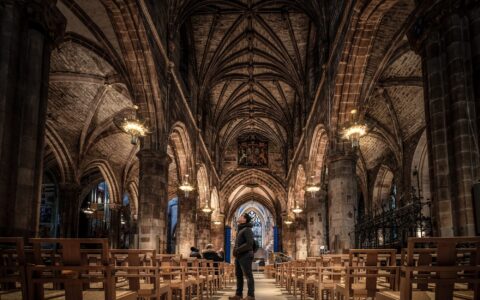No visit to Edinburgh is complete without a visit to the magnificent St Giles Cathedral. Located in the heart of the city, this stunning Gothic building is one of the city’s most beautiful and historically significant churches. It has been an important place of worship, education and public events for centuries, and remains a popular attraction in Edinburgh today.
St Giles Cathedral is without doubt the most emblematic religious building in the Scottish capital. It is one of the most important ecclesiastical buildings in Scotland. First of all because its origins date back to the 12th century.
Indeed, the original church was founded by King David I of Scotland in 1124 AD, and was then known as the High Kirk of Edinburgh.
In constant renewal, the church has been rebuilt several times over the centuries, and the current building is largely the result of renovations undertaken in the mid-19th century.
The cathedral is named after St. Giles, the patron saint of Edinburgh, but is also associated with some of the most important figures in Scottish history, including King James VI and Mary, Queen of Scots.
The cathedral has been the site of many important events in Scottish history, including the coronation of King James VI and the signing of the National Covenant in 1638.
It was also a site of political protest during the Scottish Reformation, and the site of religious debate during the Scottish Enlightenment.

St Giles cathedral – © Puripat
St. Giles Cathedral is a popular tourist attraction and offers an exciting glimpse into Edinburgh’s past.
It is located in the heart of the old city and is surrounded by other historic buildings and attractions. With its Gothic style, impressive spire, beautiful stained glass windows and ornate interior, St. Giles Cathedral is an essential stop on any trip to Edinburgh.
St. Gilles Cathedral is a magnificent example of Gothic architecture, with its spire, stained glass windows, and ornamentation typical of the period.
But that’s not all: the interior of the cathedral is just as impressive as the exterior, with its ornate woodwork, elaborate carvings, and exquisite stonework.
The cathedral also boasts a rich collection of artifacts, including ancient manuscripts, coins and relics… as well as some of Scotland’s most impressive works of art, including a statue of John Knox, the leader of the Scottish Reformation, and a 12th century alabaster tomb.
In addition, there are a number of important monuments and memorials, such as the memorial to the victims of the Battle of Flodden, a memorial to the victims of the Great War and a memorial to the victims of the Lockerbie bombing.
There are a number of guided tours of the cathedral, including a tour of the spire, a tour of the crypt and a tour of the cemetery. A knowledgeable guide will tell you more about the history of the building, giving you a better understanding of the history of Scotland and Edinburgh.
Visitors can also attend church services at the cathedral, which are held several times a week. The cathedral also has a gift store, where visitors can purchase souvenirs and other items.
The cathedral also hosts a number of concerts and other events throughout the year, including the annual Edinburgh Festival, which features music, theater and other performances. The cathedral is also a popular venue for weddings, and couples can choose to get married in the beautiful chapel.
For foodies, you should know that the cathedral has a café, where visitors can purchase food and drinks.
 Address:
Address:
 GPS :
GPS :
 Visit duration:
Visit duration:
 Site Web :
Site Web :
 Prices:
Prices:  Opening hours:
Opening hours: